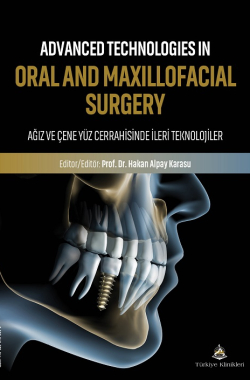3D PRINTING IN ORAL AND MAXILLOFACIAL SURGERY: TRANSFORMING TREATMENT APPROACHES
Raha Akbaṙıhamed
Ankara Medipol University,Faculty of Dentistry, Department of Oral and Maxillofacial Surgery, Ankara, Türkiye
Akbarihamed R. 3D Printing in Oral and Maxillofacial Surgery: Transforming Treatment Approaches. Karasu HA, ed. Advanced Technologies in Oral and Maxillofacial Surgery. 1st ed. Ankara: Türkiye Klinikleri; 2025. p.4149.
ABSTRACT
Threedimensional (3D) printing technology, first introduced by Charles Hull in 1986 through the development of stereolithography (SLA), has revolutionized healthcare by enabling the layerbylayer creation of complex structures. This technology has transformed traditional practices, offering solu tions that were previously unattainable. In healthcare, particularly in surgical planning, patientspecific anatomical models produced through 3D printing allow for detailed visualization, surgical rehearsal, and improved outcomes. These advantages have made 3D printing an indispensable tool in modern medicine.
In oral and maxillofacial surgery, the applications of 3D printing can be categorized into three main areas: anatomical models for surgical planning, patientspecific surgical guides, and customdesigned implants. Data obtained from imaging techniques such as computed tomography (CT), conebeam computed tomography (CBCT), and magnetic resonance imaging (MRI) are processed into STL files via advanced software and used for 3D printing. These models and guides are instrumental in proce dures requiring precision, such as implant placement, tumor resections, and trauma management.
The technology has proven particularly transformative in dental implantology, tumor and cyst resection, trauma reconstruction, and the treatment of temporomandibular joint (TMJ) disorders. Patientspecific surgical guides ensure accurate implant placement and bone resections, reducing the risk of surgical errors. Moreover, in aesthetic and reconstructive surgery, 3D printing facilitates facial contouring, prosthetic design, and orthognathic procedures, offering unmatched precision and customization.
Despite its significant potential, the widespread adoption of 3D printing in healthcare faces several challenges. High costs, limited availability of biocompatible materials, and the complexity of the de sign and manufacturing processes remain significant barriers. Addressing these challenges is essential for broader clinical integration and fully harnessing this transformative technology’s potential.
In conclusion, 3D printing reshapes oral and maxillofacial surgery by enabling personalized, precise, and efficient treatment approaches. By bridging the gap between preoperative planning and surgical execution, this technology enhances surgical outcomes and redefines the possibilities within this field.
Keywords: Printing; ThreeDimensional; Surgery; Oral; Orthognathic surgical procedures; Biocompatible materials; Temporomandibular joint
Kaynak Göster
Referanslar
- Hull CW. Apparatus for production of three-dimensional objects by stereol3thography. US Patent 4575330A. [Link]
- Shafiee A, Atala A. Printing technologies for medical applications. Trends Mol Med. 2016;22(3):254-65. [Crossref] [PubMed]
- Paul GM, Rezaienia A, Wen P, Condoor S, Parkar N, King W, Korakianitis T. Medical applications for 3D printing: recent developments. Mo Med. 2018;115(1):75. [PMC]
- Cornejo J, Cornejo-Aguilar JA, Vargas M, Helguero CG, Milanezi de Andrade R, Torres-Montoya S, Russomano T. Anatomical Engineering and 3D printing for surgery and medical devices: international review and future exponential innovations. B3omed Res Int. 2022;2022(1):6797745. [Crossref] [PubMed] [PMC]
- Mankovich NJ, Cheeseman AM, Stoker NG. The display of three-dimensional anatomy with stereolithographic models. J Digit Imaging. 1990;3:200-3. [Crossref] [PubMed]
- Marro A, Bandukwala T, Mak W. Three-dimensional printing and medical imaging: a review of the methods and applications. Curr Probl Diagn Radiol. 2016;45(1):2-9. [Crossref] [PubMed]
- Oberoi G, Nitsch S, Edelmayer M, Janjić K, Müller AS, Agis H. 3D printing-encompassing the facets of dentistry. Front Bioeng Biotechnol. 2018;6:172. [Crossref] [PubMed] [PMC]
- Moroni L, Boland T, Burdick JA, De Maria C, Derby B, Forgacs G, et al. Biofabrication: a guide to technology and terminology. Trends Biotechnol. 2018;36(4):384-402. [Crossref] [PubMed]
- Zhang YS, Yue K, Aleman J, Moghaddam KM, Bakht SM, Yang J, et al. 3D bioprinting for tissue and organ fabrication. Ann Biomed Eng. 2017;45(1):148-63. [Crossref] [PubMed] [PMC]
- Dadhich A, Nilesh K, Shah S, Saluja H. Three- dimensional printing in maxillofacial surgery: a quantum leap in future. Natl J Maxillofac Surg. 2022;13(Suppl 1):S203-11. [Crossref] [PubMed] [PMC]
- Dawood A, Marti Marti B, Sauret-Jackson V, Darwood A. 3D printing in dentistry. Br Dent J. 2015;219(11):521-9. [Crossref] [PubMed]
- Jacobs CA, Lin AY. A new classification of 3D printing technologies: systematic review of orthopedic surgery. BMC Musculoskelet Disord. 2017;18:314. [Link]
- Kilinç FS, Han SH. The role of 3D printing in oral and maxillofacial surgery: a review. J Stomatol Oral Maxillofac Surg. 2022;123(1):20-7.
- Goh BT, Lee S, Tideman H, Stoelinga PJW. 3D computeraided design and manufacturing in craniomaxillofacial surgery: a review of recent technologies. Int J Oral Maxillofac Surg. 2015;44(7):887-97.
- Louvrier A, Marty P, Barrabé A, Euvrard E, Chatelain B, Weber E, Meyer C. How valuable is 3D printing in maxillofacial surgery? J Stomatol Oral Maxillofac Surg. 2017;118(4):206-12. [Crossref] [PubMed]
- Edgar J, Tint S. Additive manufacturing technologies: 3D printing, rapid prototyping, and direct digital manufacturing. Johnson Matthey Technol Rev. 2015;59(3):193-8. [Crossref]
- Mostafaei A, Elliott AM, Barnes JE, Li F, Tan W, Cramer CL, et al. Binder jet 3D printing-process parameters, materials, properties, modeling, and challenges. Prog Mater Sci. 2021;119:100707. [Crossref]
- Chia HN, Wu BM. Recent advances in 3D printing of biomaterials. J Biol Eng. 2015;9(1):4. [Crossref] [PubMed] [PMC]
- Mavili ME, Canter HI, Saglam-Aydinatay B, Kamaci S, Kocadereli I. Use of three-dimensional medical modeling methods for precise planning of orthognathic surgery. J Craniofac Surg. 2007;18:740-7. [Crossref] [PubMed]
- Shahrubudin N, Lee TC, Ramlan RJ. An overview on 3D printing technology: technological, materials, and applications. Procedia Manuf. 2019;35:1286-96. [Crossref]
- Kouhi M, de Souza Araújo IJ, Asa'ad F, Zeenat L, Bojedla SSR, Pati F, et al. Recent advances in additive manufacturing of patient-specific devices for dental and maxillofacial rehabilitation. Dent Mater. 2024;[Epub ahead of print]. [Crossref] [PubMed]

